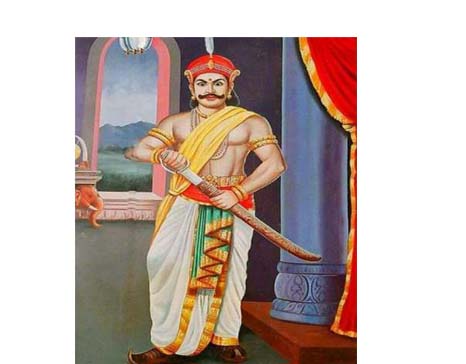Veerapandiya Kattabomman was a Palayakarrar or Polygar from Panchalankurichi in the Tamil Nadu district of Thoothukudi (formerly Tirunelveli). Kattabomman Nayak of Panchalankurichi Palayam was his other name. His parents were Jagaveera Pandiya Kattabommu and Arumugathammal. On February 2, 1790, he began his reign.
Though most historical accounts refer to the revolt of 1857 as India’s First War of Independence, they seem to overlook many accounts of sacrifices and one such is about a brave chieftain from Tamil Nadu in the late 18th century who refused to acknowledge the British East India Company’s sovereignty and waged war against the colonialists on his own.
In the year 1760, Veerapandiya Kattabomman was born. To avoid marriage ties with the Muslim King and to preserve Hindu tradition, the Kattabommu’s ancestors migrated from Andhra Pradesh to a place called Salikulam. “They were great fighters that fought till their last breath and belonged to the Thogalavar community. In acknowledgment of his bravery and fighting ability, the first of the Kattabommu family to settle in Salikulam was appointed as a Chief Guard to the then King Sri Jaga Veera Pandian of Veerapandiyapuram.
‘We are the sons and daughters of this land. We live in a world of prestige, honour, and dignity, and we sacrifice our souls for the sake of our country’s reputation, honour, and dignity. We don’t prostrate ourselves in front of foreigners. We will fight till we are dead’
— Veerapandiya Kattabomman
Kattabommu earned the King’s trust via his dedication and devotion, and he became his dependable guard. King Jagaveera Pandiyan crowned Kattabommu as his heir to the throne since he lacked an heir to the throne. Kattabommu called himself Jaga Veera Pandiya Kattabommu in honour of the King and efficiently ruled the State with vim and passion.
British Plot To Force Indians into Slavery
The Kattabommu dynasty’s 47th generation was Veerapandiya Kattabomman. He was the eldest son of Jagaveera Pandya Kattabommu and Arumugathammal. Veerapandiya Kattabomman was crowned on February 2, 1790, in his thirty-first year, and effectively ruled over 96 villages which were reorganised into six divisions. He managed the State with a great deal of skill in terms of administration, justice, and welfare. He had cordial connections with the neighbouring States.
In 1781, the British East India Company received permission from the Nawab of Arcot to collect land revenues. It was renewed in 1785, and by 1795, they had enlisted the help of additional Southern States. They had set limits on the construction of forts and the establishment of armed formations, as well as declared that the rulers were just ordinary contractors who may face disciplinary punishment like any other citizen if they refused to obey their orders. Kattbomman refused to accept the notice, claiming that it was a British plot to deny the State’s rights and force the Indians into slavery.
Uniting Southern Rulers Against British
Kattabomman pledged to reject the British initiative. He gathered all of his neighbouring rulers, including those from Nagalapuram, Elayiram Pannai, Kolarpatti, Kadalgudi, Kulathor, Sivagiri Zamindars, Sivakanga Maruthu Brothers, and a section of the Ramnad King’s family, to form a union to fight the British attempt to rule over the Southern territories.
Kattabomman, on the other hand, was unsuccessful in his attempt, as the British were effective in fomenting animosity among territorial authorities. Despite persistent British pressure, Kattabomman remained defiant and refused to capitulate and pay the taxes.
In 1798, Jackson was appointed Collector of Tirunelveli. Kattaboman refused to pay taxes after numerous reminders. Jackson was fired as collector following a few clashes between the British and Kattaboman. Lousington was appointed Collector of Tirunelveli in 1799.
Kattabomman was also invited to visit him. Kattaboman, on the other hand, refused to comply with the requirement. Kattabomman flatly refused and stayed firm in his belief that paying taxes to the British would be unjust.
The British unexpectedly invaded Panchalamkurichi on September 5, 1799, while the entire Panchalamkurichi population was at Tiruchendur for a festival celebration. Major Bannerman commanded the British Army. Kattabomman’s well-managed informers had learned about the plan to launch a surprise attack well in advance. He had kept his men ready for an invasion by the British. Prior to the attack, Major Bannerman sent a message to Kattabomman, asking him to surrender. Kattabomman replied by saying that, “We are the sons and daughters of this land. We live in a world of prestige, honour, and dignity, and we sacrifice our souls for the sake of our country’s reputation, honour, and dignity. We don’t prostrate ourselves in front of foreigners. We will fight till we are dead.”
The war began. Intense conflict began between both sides. He was critically injured on the last day of the conflict and was taken into the kingdom of King Pudukotta by his aides.
When the British learned that Kottaboman was in Pudukotta’s kingdom, they demanded the King to surrender Kottaboman. Kattabomman was apprehended by the troops of King Pudukottai on September 24, 1799, and handed over to the British.
No Compromise On Principles
Kattabomman was arrested and taken to the Kayathar jail. On October 16, 1799, the Court started a trial against Kattabomman and he was executed. He did not flinch in the face of death, and he continued to uphold his principles of respect, dignity, and pride. He also stood up for his homeland’s rights and chastised the British for their immoral and illegal occupation. Subramania Pillai, his companion, was also hanged, and his head was displayed on a spike near Panchalankurichi. Soundara Pandian, another associate, was brutally murdered by slamming his skull against a wall. Oomaidurai, Kattabomman’s brother, was imprisoned.
In his honour, the Indian Postal Service issued a stamp. In Tamil Nadu’s Kayathar village, the Government has built a memorial for Kattabomman. There are statues of him all around Tamil Nadu. INS Kattabomman is the Indian Navy’s communication centre. It is high time that we Indians honour Veerapandiya Kattabomman’s patriotism, bravery, and sacrifice.




















Comments